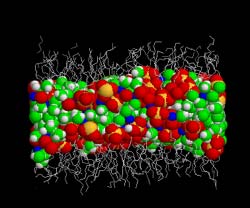Surprising new water property discovered

Image of computer simulations of water molecules behaviour
At a microscopic level, water molecules behave rather like the needle of a compass. Just as the needle moves when surrounded by a magnetic field (such as that of the Earth), water molecules move slightly in one direction when there is an electric field. Or at least that is what physicists thought till now. Research at the Universitat Autònoma de Barcelona has shown that, in water trapped in the bubbles of a detergent, it is not quite like that: water molecules have a surprising ability to organize themselves in complex structures, which, when in the presence of the detergent’s electric field (created by the action of certain chemical compounds), organize themselves to cancel this out and even invert it.
Professors Jordi Faraudo of the Department of Physics at the Universitat Autònoma de Barcelona and Fernando Bresme, from London University’s Imperial College, publish this surprising result in Physical Review Letters. Their paper deals with a fascinating discovery on the nature of water that will allow us to better understand complex behaviour such as that of biological membranes.
The research has been carried out by means of simulations, using supercomputers, of the behaviour of water molecules and their interaction with the molecules of a chemical compound frequently used in commercial detergents called SDS. In the simulations, carried out in Europe’s most powerful supercomputer laboratories in Edinburgh, the scientists have observed completely abnormal behaviour.
Current theories led us to believe that the detergent compound SDS acted to produce an electric field around itself by simply orienting neighbouring water molecules without significantly changing the normal properties of water. Thus, it was thought that the molecules aligned themselves with the applied electric field just as a compass needle does in the magnetic field of the Earth. This phenomenon is known as water polarization and is well known by scientists, having important implications for biological and chemical processes related with electrical interactions in water: interaction between membranes, the formation of films and foams, and colloidal stability, among others.
However, the results obtained by this research show that, under certain circumstances, water prefers to behave in a completely abnormal way and to organize itself. In prime films formed by water and SDS (such as those found in foam and bubbles), water molecules are immobilized and cluster together forming special structures, about three molecules thick, around the SDS molecules. Behaving in this way, water manages to completely cancel out the electric field created by the detergent and even to invert it. Hence, to the contrary of what was thought up to now, the action of these detergent chemical compounds is determined mainly by how far water molecules “tolerate” or oppose their presence.
Media Contact
More Information:
http://www.uab.es/uabdivulga/engAll latest news from the category: Life Sciences and Chemistry
Articles and reports from the Life Sciences and chemistry area deal with applied and basic research into modern biology, chemistry and human medicine.
Valuable information can be found on a range of life sciences fields including bacteriology, biochemistry, bionics, bioinformatics, biophysics, biotechnology, genetics, geobotany, human biology, marine biology, microbiology, molecular biology, cellular biology, zoology, bioinorganic chemistry, microchemistry and environmental chemistry.
Newest articles

Properties of new materials for microchips
… can now be measured well. Reseachers of Delft University of Technology demonstrated measuring performance properties of ultrathin silicon membranes. Making ever smaller and more powerful chips requires new ultrathin…

Floating solar’s potential
… to support sustainable development by addressing climate, water, and energy goals holistically. A new study published this week in Nature Energy raises the potential for floating solar photovoltaics (FPV)…

Skyrmions move at record speeds
… a step towards the computing of the future. An international research team led by scientists from the CNRS1 has discovered that the magnetic nanobubbles2 known as skyrmions can be…





















